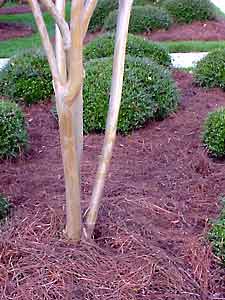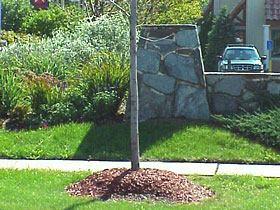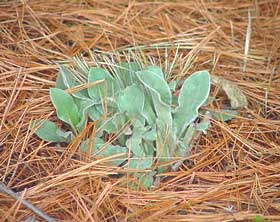
Pine straw mulch is popular in the Southeast where it's harvested from pine forests. It's attractive, conserves soil moisture, stops weed growth, and adds organic matter to the soil as it breaks down.
If there is one technique that will make your gardening easier this summer it is proper mulching. Whether it's mulching the vegetable garden, around fruit trees, amongst berry bushes, or in the herb garden, the right mulch will reduce weed growth, conserve soil moisture, make the garden look beautiful, and increase yields. The question is which mulch to use for each plant. Here's my rundown of various mulches and how to use them in your edible landscape to make it more beautiful and productive.
Vegetable Garden MulchesA mix of organic mulches is the best way to go in annual vegetable and flower gardens. Which mulch you use depends on where you live and what you're growing. Cool-season crops, such as broccoli, lettuce, greens, cabbage, peas, and pansies, do best with mulch that keeps the soil cool and moist. A 2- to 4-inch-thick layer of straw, pine straw, untreated grass clippings, or shredded dried leaves is best. Other regional mulches may work well too. (Refer to the Mulching Fruit Trees and Berries section of this article.) Avoid using hay if possible since it can be loaded with weed seeds. The added benefit of organic mulch is it will break down during the growing season, improving the soil structure and fertility.
If you're really into production, consider using soil-warming plastic mulches on heat-loving crops, such as tomatoes, peppers, squashes, cucumbers, and melons. In all but the Deep South and Southwest, plastic mulches will increase yields and encourage crops to bear earlier. Some of these mulches decrease pest attacks, too. However, in hot climates the plastic will warm the soil too much and cause a decrease in growth. And to most gardeners they're not as attractive as organic mulches.
It's not as simple as laying down black plastic anymore. Research has found that different colors of mulch increase the yields of different crops. Below is some information to help you match mulch color to crop.
Different Colored Mulches in Vegetables:Studies at Pennsylvania State University have shown an increase in yields of various vegetables grown on colored mulches compared to the same vegetable grown on black plastic mulch, averaged over a 3-year period. Most of these colored mulches are available for homeowners to purchase.
| Vegetable | Colored Mulch | Yield Increase |
| tomatoes | red | 12% |
| eggplant | red | 12% |
| peppers | silver | 20% |
| melons | green/blue | 35% |
| cucumbers | blue | 30% |
| summer squash | blue | 20% |

Organic mulch under fruit trees allows the roots to expand in the cool, damp soil without competition from weeds.
Mulching fruit trees and berry-producing shrubs is similar to mulching any woody landscape plant. Mulch not only reduces weed growth and conserves soil moisture, it also provides a barrier so lawn mowers and string trimmers won't scar the plant trunk. First remove the sod out to the drip line of the tree, shrub, or hedgerow of berry bushes. Add a 2- to 4-inch-thick layer of organic mulch around the plant. Good mulches include shredded bark, bark chips and nuggets, and pine straw. Check local nurseries and garden centers for regional organic mulches that are sustainably harvested or by-products of agricultural operations in your area. Some examples of unusual regional mulches include cottonseed, buckwheat, sawdust, corncobs, grape pomace, pine straw, and pecan, walnut, and rice hulls.Check that the crops weren't sprayed with harmful pesticides or herbicides.
There has been concern in the past about the decomposing carbon-rich mulches causing a nitrogen deficiency in the soil, but research has show that it isn't a problem on healthy soils. The bark decomposes so slowly that the soil microorganisms can digest it without using up the nitrogen in the soil meant for your plants.

Avoid "volcano" mulching -- piling new mulch on top of old until you end up with a tall mound. This technique leads to crown rot and eventually the tree's death.
If you add fresh mulch every year, remove the old mulch if it hasn't completely decomposed before adding new mulch. If mulch is allowed to build up it can create a mulch "volcano" that smothers roots and causes crown rot, eventually killing the plant. Always keep mulches a few inches away from the trunks of trees and shrubs.
It's cheapest to buy mulch in bulk, but that may not be practical. For small yards bagged mulch is fine. Consider the site and how it is used when choosing the type of mulch. Large bark nuggets are difficult to walk on and are best used along foundations and in garden beds rather than on paths. When mulching flood-prone areas and steep slopes, avoid large bark nuggets since they tend to float or wash away; instead use shredded mulch or small bark chips.
Mulching Herb and Flower Gardens
Use a 2- to 4-inch layer of mulch in perennial gardens, keeping the mulch a few inches from plant stems. Don't bury plants in the mulch or they may rot in wet weather.
Apply a light layer of organic mulch around herbs and soft-stemmed annual and perennial plants. A 1- to 2-inch-thick layer is sufficient. Consider exotic mulches in the herb garden for an unusual effect. Cocoa bean hulls, a by-product of the chocolate- making industry, give off an alluring chocolate aroma when used as mulch. This material is best for areas out of the wind (it blows away easily), doesn't flood (it will wash away) and where dogs won't be tempted to eat it (chocolate is toxic to canines). The smell won't last all summer but makes a great conversation piece and a way to get the culinary juices flowing.
Other Great Mulching StoriesOrganic Mulch Boosts Tomato Production
 Charlie Nardozzi is an award winning, nationally recognized garden writer, speaker, radio, and television personality. He has worked for more than 30 years bringing expert gardening information to home gardeners through radio, television, talks, tours, on-line, and the printed page. Charlie delights in making gardening information simple, easy, fun and accessible to everyone. He's the author of 6 books, has three radio shows in New England and a TV show. He leads Garden Tours around the world and consults with organizations and companies about gardening programs. See more about him at Gardening With Charlie.
Charlie Nardozzi is an award winning, nationally recognized garden writer, speaker, radio, and television personality. He has worked for more than 30 years bringing expert gardening information to home gardeners through radio, television, talks, tours, on-line, and the printed page. Charlie delights in making gardening information simple, easy, fun and accessible to everyone. He's the author of 6 books, has three radio shows in New England and a TV show. He leads Garden Tours around the world and consults with organizations and companies about gardening programs. See more about him at Gardening With Charlie.
 Victory Seed Company has all the seeds you want for your best garden in 2024.
Victory Seed Company has all the seeds you want for your best garden in 2024.
For 25 years, the family-owned Victory Seed Company has provided the highest quality vegetable, herb and flower seeds to families across the country. We are passionate about providing you the best seeds available that give excellent germination, robust plants, and the harvest you want. With a catalog of over a thousand varieties, we have everything, and our prices are the kinds that we'd want to pay. We have hundreds of yesterday's heirloom vegetables, as well as today's award winning hybrid selections. Get to know us by visiting our website and browsing through our online vegetable seed catalog.